Services on Demand
Journal
Article
Indicators
-
 Cited by SciELO
Cited by SciELO -
 Access statistics
Access statistics
Related links
-
 Cited by Google
Cited by Google -
 Similars in
SciELO
Similars in
SciELO -
 Similars in Google
Similars in Google
Share
Innovar
Print version ISSN 0121-5051
Innovar vol.21 no.42 Bogotá Oct./Dec. 2011
Edison Jair Duque-Oliva* & Carlos Alberto Rodríguez-Romero**
* Associate Professor, Escuela de Administración y Contaduría, Facultad de Ciencias Económicas, Universidad Nacional de Colombia, Sede Bogotá. E-mail: ejduqueo@unal.edu.co
** Associate Professor, Escuela de Administración y Contaduría, Facultad de Ciencias Económicas, Universidad Nacional de Colombia, Sede Bogotá. E-mail: carodriguezro@unal.edu.co
Submitted: February 2011 Accepted: September 2011
Abstract:
The service sector has expanded in recent decades, and, along with technological development, has sustained the appearance of virtual markets in continuous and stable growth with great potential in Latin America and with tremendous possibilities for development for the strategies of those organizations able to exploit this new medium. From that perspective, this work measures the perception by Internet purchasers of service quality, using previous scales, developing one adapted to the Colombian reality and making the corresponding tests for reliability and validity. Finally, favorable results are achieved through the scale. In conclusion, privacy, systems and variety are the dimensions most poorly rated by purchasers.
Keywords:
Perceived service quality, Internet service quality, Internet service in Colombia.
Resumen:
El sector de servicios se ha incrementado en las últimas décadas, y, sumado al desarrollo tecnológico, ha sustentado la aparición de mercados virtuales en crecimiento continuo y estable con alto potencial en América Latina y con altas posibilidades de desarrollo para la estrategia de las organizaciones que pueden aprovechar este nuevo medio. Bajo esta panorámica, este trabajo hace una medición de la percepción de la calidad del servicio de los compradores en internet, tomando las escalas previas, desarrollando una adaptada a la realidad colombiana y haciendo las correspondientes pruebas de fiabilidad y validez. Finalmente, se llega a resultados favorables para la escala. Como conclusión, la privacidad, los sistemas y la variedad son las dimensiones peor valoradas por los compradores.
Palabras clave:
calidad percibida en el servicio, calidad en el servicio de inernet, servicio de internet en Colombia.
Résumé:
Le secteur de services s'est développé durant les dernières décades et, parallèlement au développement technologique, il a provoqué l'apparition de marchés virtuels en croissance continuelle et stable avec un potentiel élevé en Amérique Latine et des possibilités importantes de développement pour la stratégie des organisations pouvant mettre à profit ce nouveau moyen. A ce sujet, ce travail réalise une mesure de la perception de la qualité du service des acheteurs sur Internet, déterminant les échelles préalables, s'adaptant à la réalité colombienne et effectuant les tests de fiabilité et de validité correspondants. Finalement les résultats sont favorables pour l'échelle. En conclusion, la privacité, les systèmes et la variété sont les dimensions les moins valorisées par les acheteurs.
Mots-clefs :
Perception de la qualité du service, qualité du service sur Internet, Service d'Internet en Colombie.
Resumo:
O setor de serviços tem crescido nas últimas décadas e, somado ao desenvolvimento tecnológico, tem sustentado a aparição de mercados virtuais em crescimento contínuo e estável com alto potencial na América Latina e com altas possibilidades de desenvolvimento para a estratégia das organizações que podem aproveitar este novo meio. Sob esta panorâmica, este trabalho realiza uma medição da percepção da qualidade do serviço, pelos compradores na internet, tomando as escalas prévias, desenvolvendo uma, adaptada à realidade colombiana, e realizando as correspondentes provas de fiabilidade e validade. Finalmente chega-se a resultados favoráveis para a escala. Como conclusão, a privacidade, os sistemas e a variedade são as dimensões pior avaliadas pelos compradores.
Palavras chave:
Percepção da qualidade do serviço, Qualidade do serviço na internet, Serviço de internet na Colômbia.
Service sector importance within production and commercial areas has been growing during the last few decades[1], gaining high participation in current economies. This sector's development has had direct implications for the rest of the economy since it represents an important intermediary in producing other goods (Jaramillo, 2004). It has also been seen to be accompanied by exponential technological development leading to gaining faster access to both information and technological elements, thereby improving productivity and producing new challenges such as virtual markets, involving studying technological tools for its safe development[2].
Virtual markets present a panorama of continuous and stable growth in B2C business figures, increasing year by year in the amount of both internaut buyers and internaut buying (AECE-FECEMD, 2005). Latin-America figures are surprising; online sales during 2005 exceeded US$4,300 million throughout the whole region and it is expected that e-business will have grown regionally at rates of at least 40% per year between 2006 and 2010 (AEI, 2006).
The e-market thus opens up a new possibility for organizational strategy given low stock costs, greater process speed, improved relationship between buyers and sellers, improved product and/or service mobility, and (because of all this) providing a service becoming a critical variable for success or failure in this market.
The literature was reviewed and a conceptual approach made to studying internet service quality, characterizing the tendencies found for dealing with it, establishing a measurement scale, making an empirical test and establishing its reliability and validity within a Colombian setting.
e-business
e-business or e-commerce is understood to mean a modern way of doing business which takes into account the needs of organisations, traders and customers/clients aimed at reducing costs whilst improving the quality of goods and services and increasing the speed of distributing these goods and services (Kalakota and Whinston, 1996). Vázquez and Berrocal (1998) have defined e-business as being any form of transaction or exchange of commercial information based on transmitting data via communication networks like internet. Schlachter (1995), Fedewa (1996), Parkinson (1999), and Timmers (1998) have classified some internet business. The Table 1 summarises such classification.
Models for evaluating internet service quality
Current models try to describe the elements which must be born in mind when evaluating customer service quality in the internet setting. Duque et al. (2006) carried out a study aimed at characterizing such models.
Dimensions are comparison elements used by subjects for evaluating different objects. Establishing differentiated dimensions or characteristics helps in schematizing and dividing the study concept or construct. Sometimes, given the subjectivity in which they are immersed, these dimensions are not so easily observable by the subjects but are rather abstractions made by them from perceived attributes or characteristics. There are primary dimensions such as adapting to use and reliability (Garvin, 1984; Juran, 1994) incorporating different perspectives, having a notoriously biased focus regarding objective quality.
The construct's different classifications for dimensions are very variable and heterogeneous as there is no consensus at the moment. What is clear is that one must begin with the interaction between customers and organizational elements and providing a particular service. This establishes three dimensions of quality (Parasuraman, Zeithaml and Berry, 1985):
- Physical quality: Including physical aspects of service;
- Corporative quality: Affecting company image; and
- Interactive quality: Interaction between personnel and customer and between customers.
Eiglier and Langeard (1996) posed the concept of "servuction" (known in English as softnomization) having three perceived dimensions, becoming the elements bought by customers (the quality of the service being provided, the quality of the elements intervening in the process of providing the service, and the quality of the process of providing the service). The authors stated that the three dimensions were interrelated and that service quality could only be achieved if quality were to be ensured in all three.
Grönroos (1984) has described service quality as being a multidimensional perception variable formed by two main components: A technical or result-related dimension and a functional or process-related dimension. Grönroos (1984, 37) stated that services basically consist of intangible and subjectively-experienced processes in which production and consumption activities happen simultaneously. Interactions including a series of "moments of truth" are produced between the customer and the service provider.
The dimension of functional quality cannot be evaluated in such an objective way as technical dimension due to its sundry degrees of intangibility. Grönroos (1984, 40) related these two dimensions of service quality to corporate image, since such image can determine what is expected of the service being provided by an organization.
Studying such multidimensionality led to the first approach in an unpublished document[3] (Fin and Kayande, 2003) which analysed the dimensions which were born in mind by some prior investigations and even some web pages for measuring satisfaction with their use. The authors stated that the scales' objectives were usually aimed at determining what users were seeking or establishing aspects regarding a particular website's performance/function. Duque et al. (2006) wished to follow a different procedure, initially comparing each model's main characteristics, bearing in mind whether the authors' objective was to develop a scale, the concept behind such evaluation and the approach so adopted. Duque et al. (2006) classified models according to the Table 2.
Duque et al. (2006) found two marked tendencies in evaluation and another very tenuous one. One group of models used a quality-based approach to evaluation and another group a satisfaction-based approach. A third group had an independent approach towards value, publicity or buying/selling. The study also analyzed whether the models sought to establish a measurement scale.
The theoretical basis for the perceived internet service quality construct concerns service quality in traditional settings (Cronin and Taylor, 1992; Dabholkar, 1996; Parasuraman, Zeithaml and Malhotra, 2005) and consumers' buying patterns/behaviour. The paradigm of expectations not having been confirmed served as a starting point for the appearance of alternatives for evaluating quality in the internet (Caruana and Pitt, 1997; Schubert and Selz, 1999; Alpar, 1999; Szymanski and Hise, 2000; Yoo and Donthu, 2001; Zhang and von Dran, 2000; Barnes and Vidgen, 2002; Francis and White, 2004a, 2004b; Loiacono et al., 2002, 2005; Palmer, 2002; Yang and Jun, 2002; Park and Kim, 2003; Srinivansan et al., 2003, 2005; Wolfinbarger and Gilly, 2003; Parasuraman, Zeithaml and Malhotra, 2000, 2004, and Webb and Webb, 2004).
The dimensions established for measuring perceived service quality reflect contextualized and applied sales' aspects in internet in the light of the concepts of quality, satisfaction and value, in spite of the difficulty of delimiting such concepts (Parasuraman et al., 1988; Woodruf, 1997, and Gil et al., 2004). Such contextualization characterizes the internet market by developing dimensions having greater application in this setting, becoming separated from evaluating perceived service quality in a traditional setting[4]. The fact of continuing the scheme of evaluating perceived service quality in traditional settings could be due to a high level of association between service quality constructs and concepts of satisfaction and value, given that they are the main evaluations of consumption experiences (Gil et al., 2004, p. 4).
There are many studies, reflections and investigations about perceived service quality, its background and consequences, and the elements or dimensions explaining service users' perception, justifying this construct's importance in the internet setting. However, Duque et al. (2006) presented Parasuraman, Zeithaml and Malhotra's model (2005) as that best capturing the development of the construct and its evaluation strategies, meaning that this scale supports this work's empirical application.
Zeithaml, Parasuraman and Malhotra (2000) proposed analyzing the elements to be taken into account when studying internet service quality. They established an e-service quality model in 2002, adding new elements such as navigation, efficiency and access, given the characteristics of online purchasing and capturing aspects regarding ease of use and usefulness supporting acceptance of information technologies. Parasuraman, Zeithaml and Malhotra (2004, 2005) presented structured work accompanied by validity and reliability tests in their publication for the Marketing Sciences Institute. Another reason for choosing this scale is that the authors' internet version has been most cited (Duque et al., 2006). The Figure 1 shows the relationships.
The scale used in this investigation was based on analysing Parasuraman, Zeithaml and Malhotra's scale (2005) within an internet context and in the light of other work which could contribute towards its conceptual improvement. This scale was complemented or contrasted with others in each dimension (Parasuraman, Zeithaml and Malhotra, 2004; Szymansky and Hise, 2000; Evanschitzky et al., 2004; Weijters and Schillewaert, 2006). Table 3 shows the scale's dimensions (which were support scales) and the number of variables for the theoretical scale of internet service quality.
The questionnaire was structured in two parts. The first block meant that each person surveyed had to reply to some classification data (basically behavioural data) and information about the site habitually used for making purchases in internet; the second block contained the scale. The scale used in this investigation had 5 dimensions and 24 items.
A pre-test was performed using 50 Master in Administration students. The necessary adjustments were then made to the form so that they could be filled in via internet over a period of a month. EQS version 6.1 was used for analyzing the 135 forms returned. Information was collected from internet buyers online; 150 filled-in forms were obtained, of which 15 were eliminated as they presented inconsistencies and had not been fully filled in.
Once the database had been obtained, Vila, Kuster and Aldas' scale validation (2005) was used for determining whether the measurement process had been suitably developed. The statistical part of this work was based on Hair et al. (2004).
All the questionnaires were valid for the analysis. The perceived quality model initially included 24 variables for evaluating 5 factors regarding service quality.
Exploratory analysis of the internet service quality scale
An exploratory factorial analysis was applied to the database for ascertaining the variables' initial behaviour/pattern.
Factorial analysis results were considered satisfactory as they explained around 77% of total extracted variance and factorial load/weighting was higher than 0.5, implying that correlation amongst the variables was highly significant.
Regarding Cronbach's alpha for each dimension, the study initially presented the results presented in the Table 4. The following sphericity test was used for testing the hypothesis that all the variables had the same variance and were not correlated:

Based on the variance and covariance matrix, this hypothesis was tested as follows:

where S was the scale's variance and covariance matrix.
Variance was given by the sum of the diagonals of the corelation matrix concerning the number of variables taken; i.e.

The test result was compared to a Chi-squared distribution with (p+2)(p-1)/2 degrees of liberty. The test produced the following results for this quality scale:

This value was compared with a Chi-square having 299 degrees of liberty and 340.32 value.
This value was clearly statistically significant, meaning that variables having the same variance and which were not correlated were thus rejected.
The percentage of variance explained for each attribute (expressed in terms of communalities) was acceptable on being above 0.5 (Hair et al., 2004) in all cases.
Regarding the dimension's reliability (measured by Cronbach's alpha), the scale's reliability was good since this value was 0.93 and minimum accepted value should have been 0.7 (Nunnally, 1978). Table 5 gives a summary of the exploratory factorial analysis results.
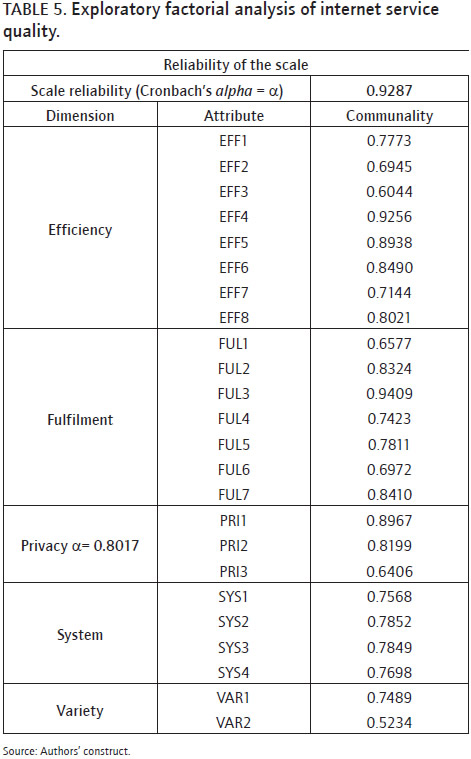
Confirmatory analysis of the internet service quality scale
In spite of exploratory factorial analysis showing high reliability for the scale, confirmatory factorial analysis was aimed at establishing how dimensions fit the model and verifying their validity (Vila et al., 2005).
Adjusting the scale (convergent validity)
The scale's adjustment was evaluated by using goodness of fit indicators (GFI, AGFI, RMSEA, NFI, CFI); Table 6 shows the results for the indicators.
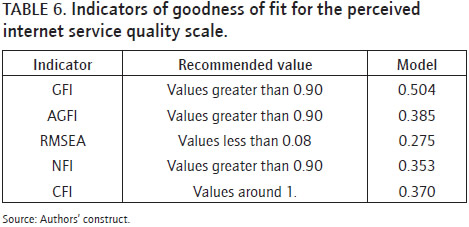
Goodness of fit data revealed that the values were not acceptable (Hair et al., 2004), in spite of the excellent reliability seen with the good Cronbach's alpha value.
Lagrange and Wald tests were evaluated by following Vila, Kuster and Aldas's procedure (2005). Some relationships were thus found which could be loaded from the theoretical point of view[5]. The procedure's idea was to increase the indicators of fit, taking the reduced Chi squared values for previously declared relationships as starting point. Goodness of fit indicators were compared by adding proposed and coherent relationships to theoretical support; the result was not positive, as NFI, NNFI, CFI, AGFI indicators continued being extremely low whilst Cronbach's alpha was not substantially modified.
The information supplied by the Wald test led to the variables being eliminated one by one, providing prior verification of its conceptual importance within the analysis, to the point where the aforementioned indices became suitable to fit the model.
Variables were iteratively eliminated as follows: EFF6, EFF7, FUL1, FUL3, FUL7, EFF5, FUL5, SYS 4, EFF1, FUL4, and FUL6; this was done so that the model produced a suitable value for the statistics such as NFI (0.896), NNFI (0.780), CFI (0.916), and AGFI (0.708). This conserved the supposition of symmetry of errors and care so that Cronbach's alpha gave a good result (0.876). The dimensions were conserved, but variables were eliminated which were producing imbalance in the model and, conceptually, did not change the sense of evaluation.
Table 7 shows the indicators of goodness of fit for the corrected model.
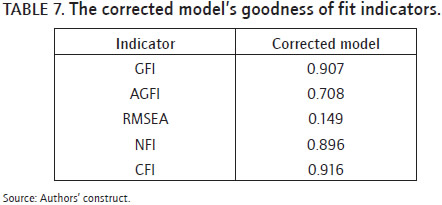
It could thus be said that the model had convergent validity in the terms established by Vila et al. (2005).
Analysis of covariance (discriminant validity)
Table 8 shows the analysis of covariance amongst factors.
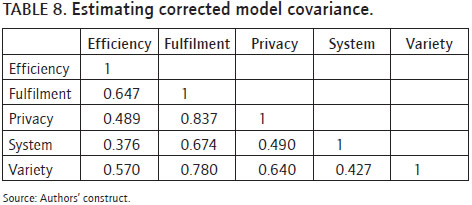
Studying corrected model covariance led to observing that there might have been a relationship between factors 2 and 3 (fulfilment and privacy). Anderson and Gerbin's test was used for evaluating whether such co-relationship was statistically significant; a 0.721 to 0.953 confidence interval was found for these two factors. As this interval did not contain 1, it was observed that these two factors were independent of each other with this model. This led to concluding that there was discriminant validity in the corrected model's scale. Figure 2 presents convergent and discriminant validity.
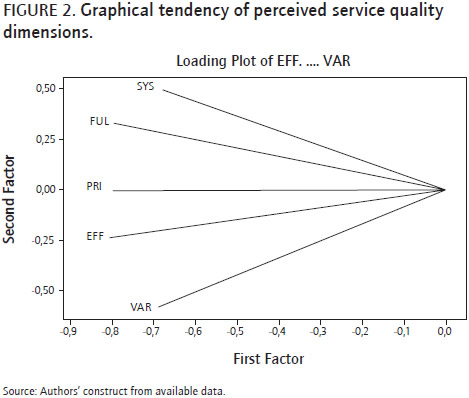
The work started by synthesizing the different ways of operationalizing the perceived internet service quality construct (Caruana and Pitt, 1997; Lozier and Thomas, 2000; Yoo and Donthu, 2001; Zhang and von Dran, 2000, Barnes and Vidgen, 2002; Yang and Jun, 2002, and Parasuraman, Zeithaml and Malhotra, 2000 and 2004). The components helping to measure the construct were based on previous work (Duque et al., 2006) in which it was found that theoretical support for the perceived internet service quality construct arose from perceived service quality in traditional settings (Cronin and Taylor, Dabholkar, Oliver and Parasuraman, Zeithaml and Malhotra) and consumers' purchasing behaviour/patterns. The dimensions so established reflected sales' aspects contextualized and applied in internet. Such contextualization characterized the internet market, developing dimensions having greater application in such setting and being noticeably separated from evaluating perceived service quality in a traditional setting. The fact of continuing the scheme of evaluating perceived service quality in traditional settings could have been due to the high level of association between perceived service quality constructs and the concepts of satisfaction and value, given that they provided the main evaluations of consumption experience (Gil et al., 2004, 4).
This work constitutes a source for further research, such as the effect of other constructs on perceived service quality and customer satisfaction and loyalty. Given that it was found that perceived service quality construct treatment did not differ from treatment in traditional settings, one option is to move discussion of background and consequences regarding perceived quality for determining differences or similarities to other constructs. This could result in future investigations including specificities in their evaluation systems, according to the application context or setting and/or focusing on specific populations. The possibility of continuing may be extended towards generalizing or carrying out intercultural or cross-cultural studies. Technical characteristics could also be included from the producer's viewpoint or given the evaluation and analysis perspectives presented in the work.
Limitations arose regarding the variables of time and gaining access to information. Response time was very slow considering that this was an interactive survey. It was also corroborated that information is restricted in pages doing e-business in Colombia. This hampered contact with more buyers and more rigorous screening with e-business experts. Only two e-business experts from Colombian entities helped in the initial screening which was then verified by an external assessor for the work and finally pre-tested before being applied. What should be stressed is that when the model was applied it did not fit adequately, in spite of having passed these filters, meaning that items had to be eliminated from each scale. In the other hand, another possible limitation is sample size. 135 forms returned totally full filled are a really small sample, but because of the preliminary character of this study it is nice to describe the process in Latin America.
Apart from the perceived internet service quality construct presented here, applications could be initiated in other constructs such as loyalty and satisfaction, and their relationship with perceived quality. The concept of value is assuming a preponderant role according to the trend towards marketing development, meaning that it would be interesting to study it in an internet setting.
In Latin American case, the results above show how three important dimentions are needed to improve consumer perception: privacy, system and variety. As managerial implications, companies or organizations in this business requires to make feel consumers ecommerce is more secure in terms of the privacy and increase their variety of offers and its value in an internet setting. In the same way, system used in this process needs to be improved trying to asure people it is easy and secure.
[1] Representing more than 60% of the production of Organisation for Economic Co-operation and Development (OECD) countries (Spain is a member) and more than 50% of GDP in developing countries like Colombia.
[2] The "dotcom" crisis at the end of the 20th century revealed the importance of safely developing any particular market.
[3] This document was mentioned in an article; professor Fin was thus asked for permission to have access to it and this was very kindly given.
[4] Traditional setting refers to "bricks and mortar" and "industry-specific" meanings referring to quality in the physical setting. A traditional setting is thus referred to in this work.
[5] Trying to conserve the construct's validity.
AECE-FECEMD Asociación Española de E-negocios (2005). Estudio sobre e-negocios B2C. [ Links ]
AEI - América Economía Int. (2006). Informe especial del avance del enegocios en América Latina. Revista América Economía. [ Links ]
Alpar, P. (1999). Satisfaction with the Web site: Its measurement, factors and correlates, Fachbericht Nr. 01/99, Institut für Wirtschaftsinformatik, Philipps-Universität Marburg. [ Links ]
Barnes, S. J. & Vidgen, R. T. (2002). An integrative approach to the assessment of e-commerce quality. Journal of Electronic Commerce Research, 3(3), 114-127. [ Links ]
Caruana, A. & Pitt, L. (1997). INTQUAL - an internal measure of service quality and the link between service quality and business performance. European Journal of Marketing, 31(8), 604-616. [ Links ]
Chen, Q. & Wells, W. (1999). Attitude toward the site. Journal of Advertising Research, 39(September/October), 27-37. [ Links ]
Cronin, J. J. & Taylor, S.A. (1992). Measuring service quality: A reexamination and extension. Journal of Marketing, 56(julio), 55-68. [ Links ]
Dabholkar, P. (1996). Consumer evaluations of new technology-based self-service options: An investigation of alternative models of service quality. International Journal of Research in Marketing, 13, 29-51. [ Links ]
Duque, E. J., Cervera, A. & Rodriguez, C. (2006). Estudio bibliométrico de los modelos de medición del concepto de calidad percibido del servicio en internet. Innovar, 16(28), 223-243. [ Links ]
Eiglier, P. & Langeard, E. (1996). Servuction: Le marketing des services. New York, NY: McGraw-Hill. [ Links ]
Evanschitzky, H., Iyerb, G., Hessea, J. & Ahlert, D. (2004). e-satisfaction: a re-examination. Journal of Retailing, 80, 239-247. [ Links ]
Fedewa, C. S. (1996). Business Models for internetpreneurs. Los Angeles: Internet Entrepreneurs Support Service. Retrieved from http://www.entrepreneurs.net/iessarticles/art4.html. [ Links ]
Finn, A. & Ujwal, K. (2003). Assessing the construct validity of web service quality. Paper presented at 5th Australasian Services Research Workshop, Melbourne. [ Links ]
Francis, J. E. & White, L. (2004a). Internet retailing: Back to the future. 2004 Australian and New Zealand Marketing Academy Conference (ANZMAC). [ Links ]
Francis, J. E. & White, L. (2004b). Value across fulfillment-product categories of Internet shopping. Managing Service Quality, 14(2/3), 226-234. [ Links ]
Garvin, D. A. (1984). What does "product quality" really mean? Sloan Management Review, 26(1), 25-43. [ Links ]
Gil, I., Berenguer, G., Gallarza, M. & Moliner, B. (2004). Calidad, satisfacción y valor del servicio. Una revisión. Quaderns de Treball. #152 2004. [ Links ]
Grönroos, C. (1984). A service quality model and its marketing implications. European Journal of Marketing, 18(4), 36-44. [ Links ]
Hair, J., Anderson, R., Tatham, R. & Black, W. (2004). Análisis multivariante. 5th edition. Madrid: Ed. Prentice Hall. [ Links ]
Jaramillo, P. (2004). ¿Qué es el sector de servicios, cómo se regula, cómo se comercia y cuál es su impacto en la economía? En Archivos de Economía. Document 254. 4th May. República de Colombia, Departamento Nacional de Planeación, Dirección de Estudios Económicos. [ Links ]
Juran, J.M., Gryna, F.M. & Bingham, R.S. (1990). Manual de control de la calidad. Barcelona: Reverté. [ Links ]
Kalakota, R. & Whinston, A. B. (1996). Frontiers of electronic commerce. Reading, Mass.: Addison Wesley Longman Publishing Co., Inc. [ Links ]
Loiacono, E., Watson, R. & Goodhue, D. (2002). WebQual™: A measure of web site quality. In K. K. Evans & L. K. Scheer (eds.). Marketing Theory and Applications, Vol 13. Chicago: American Marketing Association. [ Links ]
Loiacono, E., Watson, R. & Goodhue, D. (2007). WebQual: An instrument for consumer evaluation of web sites. International Journal of Electronic Commerce, 11(3), 51-87. [ Links ]
Lozier, M. & Thomas, J. (2000). Web usability report 2000. Modalis Research Technologies. [ Links ]
Mathwick, C., Malhotra, N. & Rigdon, E. (2001). Experiential value: Conceptualization, measurement and application in the catalog and internet shopping environment. Journal of Retailing, 77(Spring), 39-56. [ Links ]
Nunnally, J. (1978). Psychometric Methods. 2nd ed. New York: McGraw-Hill. [ Links ]
Palmer, J.W. (2002). Web site usability, design and performance metrics. Information Systems Research, 13(June), 151-167. [ Links ]
Parasuraman, A., Zeithaml, V. & Berry, L. (1985). A conceptual model of service quality and its implication for future research. Journal of Marketing, 49(April), 41-50. [ Links ]
Parasuraman, A., Zeithaml, V., Berry, L. (1988). SERVQUAL: A multipleitem scale for measuring consumer perceptions of services quality. Journal of Retailing, 64(1), 12-40. [ Links ]
Parasuraman, A., Zeithaml, V. & Malhotra, A. (2002). Service quality delivery through web sites: A critical review of extant knowledge. Journal of the Academy of Marketing Science, 30(4), 362-375. [ Links ]
Parasuraman, A., Zeithaml, V. & Malhotra, A. (2004). E-S-QUAL: A multiple-item scale for assessing electronic service quality (Working paper). Marketing Sciences Institute. [ Links ]
Parasuraman, A., Zeithaml, V. & Malhotra, A. (2005). E-S-QUAL: A multiple-item scale for assessing electronic service quality. Journal of Service Research, 7(3) (February), 213-233. [ Links ]
Park, C.H. & Kim, Y.G. (2003). Identifying key factors affecting consumer purchase behavior in an online shopping context. International Journal of Retail & Distribution Management, 31(1), 16-29. [ Links ]
Parkinson, J. (1999). Retail models in the connected economy: Emerging business affinities. Online document. [ Links ]
Schlachter, E. (1995). Generating revenues from websites. Board Watch, (July), 374. [ Links ]
Schubert, P. & Selz, D. (1999). Web assessment - measuring the effectiveness of electronic commerce sites going beyond traditional marketing paradigms. In Proceedings of the 32nd Hawaii International Conference on System Sciences - 1999. 0-7695-0001-3/99 (c) 1999 IEEE. [ Links ]
Srinivasan, A., Anderson, R. & Ponnavolu, K. (2002). Customer loyalty in e-commerce: An exploration of its antecedents and consequences. Journal of Retailing, 78, 41-50. [ Links ]
Szymanski, D. M. & Hise, R. T. (2000). E-satisfaction: An initial examination. Journal of Retailing, 76(3), 309-322. [ Links ]
Timmers, P. (1998). Business models for electronic markets. Electronic Markets, 8(2), 3-8. [ Links ]
Vázquez, E. & Berrocal, J. (1998). E-negocios: visión general. Bit Digital, (113). [ Links ]
Vila, N., Kuster, I. & Aldas, J. (2005). Desarrollo y validación de escalas de medición en mercadeo. Universidad de Valencia. Material del curso Análisis de Data Avanzado. [ Links ]
Webb, H.W. & Webb, L.A. (2004). SiteQual: An integrated measure of Web site quality. The Journal of Enterprise Information Management, 17(6), 430-440. [ Links ]
Weijters, B. & Schillewaert, N. (2006). (R)e-tail satisfaction: Retail customer satisfaction in online and offline contexts. Vlerick Leuven Gent Management School Working Paper Series 2006/08. [ Links ]
Wolfinbarger, M. & Gilly, M. (2003). eTailQ: Dimensionalizing, measuring, and predicting etail quality. Journal of Retailing, 79(3), 183-98. [ Links ]
Woodruff, R.B., Cadotte, E. R. & Jenkins, R. L. (1983). Modelling consumer satisfaction processes using experienced-based norms. Journal of Marketing Research, 20, 296-304. [ Links ]
Yang, Z. & Jun, M. (2002). Consumer perception of e-service quality: From internet purchaser and non-purchaser perspectives. Journal of Business Strategies, 19(1), 19-41. [ Links ]
Yoo, B. & Donthu, N. (2001). Developing a scale to measure the perceived quality of an internet shopping site (Sitequal). Quarterly Journal of Electronic Commerce, 2(1), 31-46. [ Links ]
Zeithaml, V. A., Parasuraman, A. & Malhotra, A. (2000). A conceptual framework for understanding e-service quality: Implications for future research and managerial practice (MSI Working Paper Report No. 00-11). [ Links ]
Zhang, P. & Von Dran, G. (2000). Satisfiers and dissatisfiers: A two-factor model for website design and evaluation. Journal of the American Society for Information Science, 51(14), 1253-1268. [ Links ]














